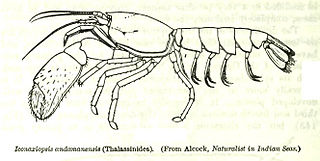
Alfred William Alcock was a British physician, naturalist, and carcinologist.

The family Polychelidae contains thirty-eight extant species of blind, benthic lobster-like crustaceans. They are found throughout the world's tropical, sub-tropical and temperate oceans, including the Mediterranean Sea and the Irish Sea.

Comitas is a genus of medium-sized sea snails, marine gastropod molluscs in the family Pseudomelatomidae.

Argopecten is a genus of saltwater clams, or scallops, marine bivalve mollusks in the family Pectinidae.

Eiconaxius is a genus of mud lobster that includes the following species:

Munidopsis is a genus of squat lobster. It is the second largest of all the genera of squat lobsters, after Munida, with over 200 species. Its members are mainly found on continental slopes and on abyssal plains. A few fossil species are also known, including specimens from the Campanian (Cretaceous).

Cucumariidae is a family of sea cucumbers, marine animals with elongated bodies, leathery skins and tentacles that are found on the sea bed.
Bathycongrus macrocercus is an eel in the family Congridae. It was described by Alfred William Alcock in 1894, originally under the genus Congromuraena. It is a marine, deep water-dwelling eel which is known from the Andaman Islands, in the eastern Indian Ocean.
Bathycongrus nasicus is an eel in the family Congridae. It was described by Alfred William Alcock in 1894, originally under the genus Congromuraena. It is a marine, deep water-dwelling eel which is known from the Indian Ocean, including the Arabian Sea, the Bay of Bengal, and the Gulf of Aden. It dwells at a depth range of 230–1040 metres.
Gnathophis musteliceps is an eel in the family Congridae. It was described by Alfred William Alcock in 1894, originally under the genus Congromuraena. It is a marine, deep water-dwelling eel which is known from the Bay of Bengal, in the western Indian Ocean. It dwells at a depth range of 265–457 metres.
Rhynchoconger squaliceps is an eel in the family Congridae. It was described by Alfred William Alcock in 1894, originally under the genus Congromuraena. It is a marine, tropical eel which is known from the Bay of Bengal, in the western Indian Ocean. It is known to dwell at a depth of 234 metres (768 ft).
Xenomystax trucidans is an eel in the family Congridae. It was described by Alfred William Alcock in 1894. It is a marine, deep water-dwelling eel which is known from Maldives and Laccadives, in the western Indian Ocean. It is known to dwell at a depth of 1,316 metres (4,318 ft), but is more commonly found at a depth range of 400 to 800 metres. Males can reach a maximum total length of 64.5 centimetres (25.4 in).

Borsonia symbiotes is a species of sea snail, a marine gastropod mollusk in the family Borsoniidae.
Garymunida prolixa is a species of squat lobster in the family Munididae. It can be found in the Andaman and Arabian Seas, at depths between about 240 and 750 metres.
Brisinga is a genus of starfish in the family Brisingidae. The species in this genus are primarily found in deep sea habitats.

Oncopagurus, is a genus of marine hermit crabs in the family Parapaguridae, which contains 25 species. Members of this genus live from 40 to 2,308 meters below the surface.

Acanthephyra is a genus of shrimp in the family Acanthephyridae, with species that live at depths from 0 to more than 5000 meters deep below the ocean surface.

Gordonella is a genus of prawns within the family Solenoceridae. There are currently 3 species assigned to the genus.

Pentacheles is a genus of crustaceans of the class Malacostraca.

Pentacheles validus is a species of decapods in the family Polychelidae. They can grow up to 77 millimetres (3.0 in).










